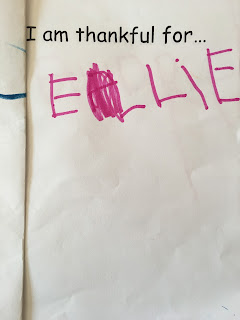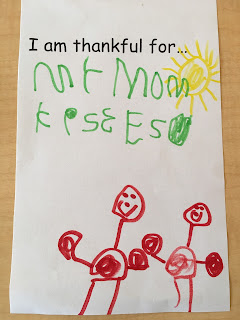It's been a great week in the Tzemach class! With Thanksgiving approaching, we've been spending some time talking about the holiday and what it means to us. Of course, we are still exploring dirt and having fun with that as well! We started the week by asking the kids what they thought "thanksgiving" meant. The majority of our answers revolved around food and playing. It opened the door for some great conversations about time spent with family and friends.
One of the main things we wanted to focus on through our study was the idea of being thankful. We discussed that being thankful is something we feel all through the year...not just on Thanksgiving. We discussed the definition of being "thankful" and agreed that it meant "to be glad you have something in your life". We decided that we tend to be thankful for the things we love and the things that mean the most to us. After talking and reading about being thankful we made a classroom thankful tree. We had the students make leaves (in any shape they wanted). They then cut them out, and wrote a word to describe what they were thankful for. After making our leaves, we decided that we wanted to use real sticks as our tree. We were able to find a nice branch that had some real leaves and acorns still on, so we thought that one would be perfect! After we finished our leaves, we hung them on our tree. We told the kids that they could add to our tree whenever they wanted to. Anytime they thought of another reason to be thankful, they could make a new leave and hang it up. We have added a hold puncher in our art center for them to use and explore. The kids have really been excited about this activity and have made everything by themselves! Their tree is sitting in the hallway under our bulletin board. If you have time, stop by and read some of their sweet notes!
During our thankful discussion we also decided it might be fun to make our own book. This is something that the kids have started doing on their own during their center time. Many of them pull out paper throughout the day and staple it and draw pictures. I think some of this was encouraged by the kindergarten class a few weeks ago. They came by our classroom with homemade books and read them to us...which the kids loved! Making books has been a hobby in our room ever since. We titled our books, "My Thankful Book". At the top of each page there is written, "I am thankful for...". In our room during read alouds, we talk a lot about what it means to be authors and illustrators. We brought this discussion up again before starting our books. We reminded the kids that they would be both the author and illustrator of this book as they would be the ones to write their thankful words and draw pictures to go along with them. This was a great time for them to focus on the beginning stages of writing. We were so impressed with how sweet and meaningful these books turned out! Several of the children were so proud of their book that they wanted to read them to the class. They chose to sit in the "teacher chair" and read their book to their friends. We made this completely optional for the kids so no one felt pressured. Both the readers and listeners seemed to really enjoy this time!
Throughout these discussions of being thankful, we have also touched on the idea of traditions. We talked about the fact that each family is different and has different ways that they celebrate Thanksgiving. We talked about differences in the foods we eat, the people we spend time with, the languages spoken in our homes, where our families come from, and any other ideas that the kids brought to the table. We found out that we all have some similarities and differences. We were able to share in our similarities and learn through our differences. It was a great discussion that will hopefully have the kids talking at home about your own family life and traditions. If anyone has any special traditions they'd like share with the class, we'd love to hear about them through pictures, artifacts, etc. Feel free to bring some stuff in or stop by to share your traditions with the class.
We also had the great opportunity of visiting the 2nd grade classroom this week! On our visit, they gave us a presentation on American Indians. They have been researching 4 different tribes from South Carolina. This was a great way for us to learn about a different culture while getting to visit the elementary school. We were able to learn so much from these 4 presentations! We learned about the culture and lifestyle of each tribe, as well as their strengths and how they are similar to us. The kids were so engaged! They made comments and asked questions. We asked the 2nd graders to include us in any of their other presentations this school year, as it was enjoyed by everyone involved!
I hope everyone has a wonderful Thanksgiving!
Love,
Ms. Rachael
Approaches to Learning:
- Reason about events, relationships, or problems.
- Demonstrate increasing ability to use prior knowledge to understand new experiences.
- Represent prior events and personal experiences in one more more ways.
- Understand a task can be accomplished through several steps.
Social & Emotional:
- Interact easily with familiar adults by engaging in conversations, responding to questions and following direction.
- Participate in group life of class.
- Display emerging social skills of trying to take turns and talk with others during play.
- Express fears and concerns to familiar adults.
Language & Literacy:
- Represent familiar people and experiences through art and language.
- Use drawings, letters, or words to create narratives about people and things in their environment.
- Combine some letters with pretend writing.
- Makes some upper case letters without regard to proportion or placement.
- Begin to understand the relationship between oral language and written language.
- Creates a pictures and labels it orally.
- Describe events of personal significance.
Mathematics:
- Organize and represent data with real objects.
- Associate at least two measurement devices with their purposes.
- Use nonstandard units of measure to compare everyday objects.
- Compare the lengths of two objects.
- Understand and use positional words to describe the locations of objects (up, down, in, over, under, behind, on top of and in front of).
- Identify and copy simple patterns.
Making leaves and decorating our thankful tree...
We are authors and illustrators! Working on our thankful books...
Some of us asked to share their story with the class....
Listening to the wonderful American Indian presentations...





































































